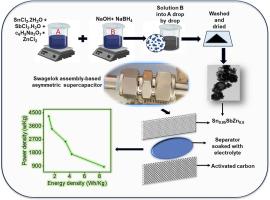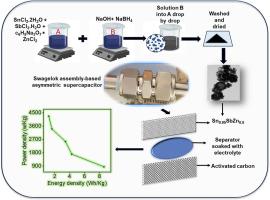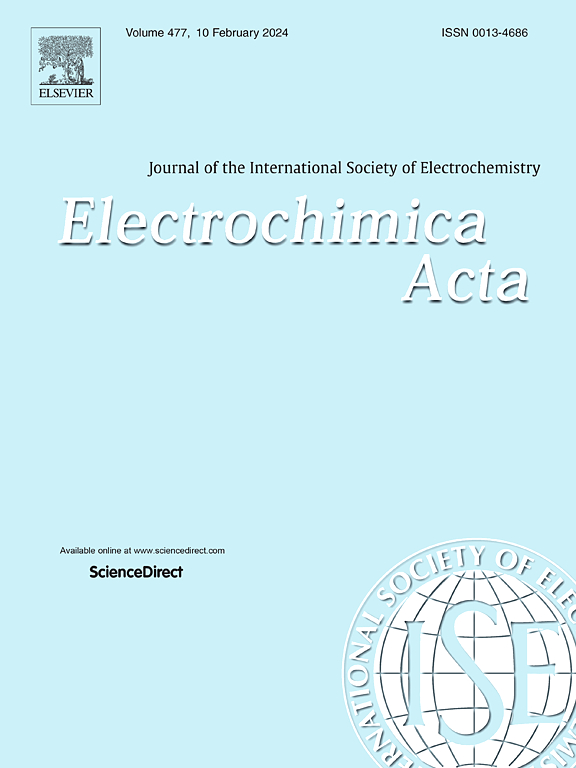用于不对称超级电容器的锌和铝掺杂锡锑的电化学特性
IF 5.6
3区 材料科学
Q1 ELECTROCHEMISTRY
引用次数: 0
摘要
与电池相比,超级电容器或电化学电容器具有高功率密度,因此以支持脉冲功率而闻名。在这项工作中,通过化学共沉淀法合成了铝和锌掺杂的 SnSb,即 Sn0.95SbZn0.05、Sn0.9SbZn0.1、Sn0.95SbAl0.05 和 Sn0.9SbAl0.1。对粉末 X 射线衍射、拉曼光谱和紫外可见光谱进行了深入研究,以推断合成材料的相形成、振动和光学特性。此外,还使用 SEM、TEM 和 X 射线光电子能谱来研究材料的形态、化学和氧化态;由于掺锌的 SnSb 比掺铝的 SnSb 具有更好的电化学性能,因此只重点研究掺锌的 SnSb。利用三电极设置,评估了 Sn0.95SbZn0.05、Sn0.9SbZn0.1、Sn0.95SbAl0.05 和 Sn0.9SbAl0.1 的电化学性能,其中 Sn0.95SbZn0.05 在 1A/g 时的比电容为 588 F/g,高于其他材料。然后,进一步进行了电化学分析,以世伟洛克组件为基础制造了一个不对称装置,其中活性炭为负极,Sn0.95SbZn0.05 为正极,并记录了 4266 W/Kg 的最大功率和能量密度值,以及 8.57 Wh/Kg 的能量密度。在 10 A/g 的条件下,它还显示出了 5000 次充放电循环的出色稳定性。本文章由计算机程序翻译,如有差异,请以英文原文为准。


Electrochemical properties of Zn and Al-doped SnSb for asymmetric supercapacitor application
Supercapacitors or electrochemical capacitors are known for their supporting pulse power because of their high-power density compared to the battery. In this work, Al and Zn doped SnSb, i.e., Sn0.95SbZn0.05, Sn0.9SbZn0.1, Sn0.95SbAl0.05, and Sn0.9SbAl0.1 have been synthesized through chemical co-precipitation method. The powder X-ray diffraction, Raman spectroscopy, and UV–visible spectroscopy are intensely scrutinised to infer the phase formation, vibrational, and optical properties of the synthesized materials. Furthermore, the SEM, TEM, and X-ray photoelectron spectroscopy are used to study the material's morphology, chemical, and oxidation state; the Zn-doped SnSb alone focused because of their better electrochemical performance than the Al-doped SnSb. Using a three-electrode setup, the electrochemical performance of the following Sn0.95SbZn0.05, Sn0.9SbZn0.1, Sn0.95SbAl0.05, and Sn0.9SbAl0.1 are evaluated in that Sn0.95SbZn0.05 has recorded higher specific capacitance of 588 F/g at 1A/g than the other. Then, the electrochemical analysis is further proceeded with the fabrication of an asymmetric device based on Swagelok assembly in which activated carbon acts as the negative electrode and Sn0.95SbZn0.05 as the positive electrode and has recorded the maximum power and energy density value of 4266 W/Kg and energy density of 8.57 Wh/Kg. It also has shown outstanding cyclic stability for 5000 charge-discharge cycles at 10 A/g.
求助全文
通过发布文献求助,成功后即可免费获取论文全文。
去求助
来源期刊

Electrochimica Acta
工程技术-电化学
CiteScore
11.30
自引率
6.10%
发文量
1634
审稿时长
41 days
期刊介绍:
Electrochimica Acta is an international journal. It is intended for the publication of both original work and reviews in the field of electrochemistry. Electrochemistry should be interpreted to mean any of the research fields covered by the Divisions of the International Society of Electrochemistry listed below, as well as emerging scientific domains covered by ISE New Topics Committee.
 求助内容:
求助内容: 应助结果提醒方式:
应助结果提醒方式:


